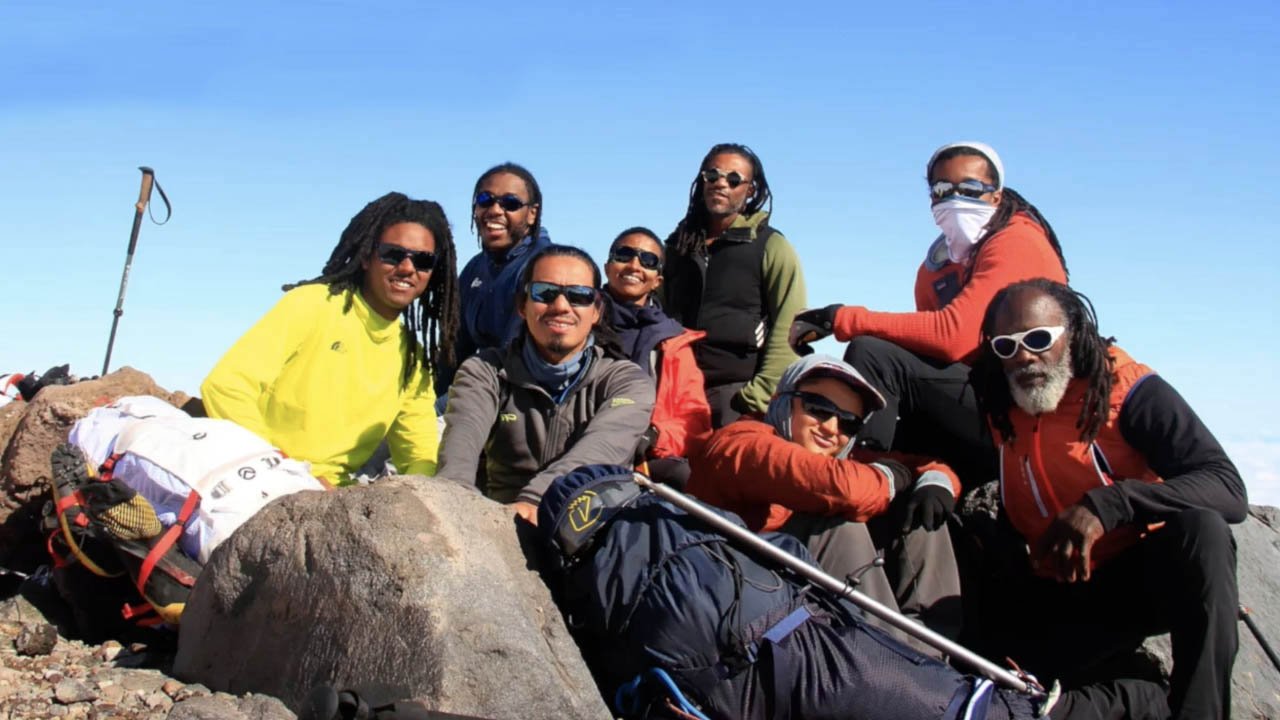Banner for Full Circle Everest on Facebook/Meta.
By Susan Messer
In spring of 2022, an inspired group of climbers became the first all-Black team to summit Everest, the highest mountain on earth. And as stated on the project’s website, Team Full Circle hopes that their historic trek will “inspire the next generation of outdoor enthusiasts, educators, leaders, and mountaineers of color to continue chasing their personal summits.” More than 6,000 have summited Mount Everest. Fewer than 10 of those climbers have been Black.
Who are these magnificent people?
Team Full Circle members live all over the US—except for James “KG” Kagambi, who joined from Kenya. In addition to all being outdoor enthusiasts, they bring a variety of backgrounds: art, sociology, electrical engineering. A science teacher, an Iraq War veteran, a small-business owner, and so on. All have plenty of climbing skill. Plus they spent months preparing, building endurance by hiking, running, and weight lifting. And they spent months in team building via twice-weekly zoom meetings to get to know each other. The group even traveled to Nepal the previous February, to train by doing local climbing and meeting the Sherpa team who helped them up Mount Everest.
Images from Full Circle Everest on Facebook/Meta.
James Kagambi, the Kenyan, age 62, was the oldest in the group and a well-respected guide and mountaineer. When Phil Henderson, Full Circle’s expedition leader, first approached him about joining the team, Kagambi refused: “My age, my knees,” he said. “The last few years have been very difficult.” But Henderson, who had climbed with Kagambi previously, persevered--appealing to his ability to motivate and communicate with people, to bring them together, a crucial piece of the trek. Moreover, for Kagambi, as his refusal gradually shifted to an acceptance, he said, “It’s not just about representing people of color, but also addressing other diversity issues such as the age gap and ageism.”
In addition to these daunting physical and psychological challenges, there is a significant financial one. “It can range from $40,000 to $150,000 per climber, and that’s just what you’re paying the outfitting company,” said Eddie Taylor, a science teacher from Colorado, and another of the climbers. “That doesn’t include your gear, insurance, flights, all those other types of things.” At first, he said, the team struggled to raise cash. Then, they received more than $160,000 in donations through a GoFundMe campaign. Community donations and funding from sponsors like North Face and the VF Foundation pushed that figure above $500,000.
“There’s a few things I hope that young kids get out of it,” Taylor said. “One, that anything’s possible. Two, that they can pick a goal and they can achieve it. And three, that these outdoor spaces are meant for them.” Also, explains Adina Scott, another member of the Full Circle team, the climbers wanted to bring things full circle in several ways—not just making it full circle to the peak and back, but bringing years of their outdoor experience and climbing back to their communities. That is, they hope to bring people into climbing who might not have previously thought of climbing, and in that way, to both highlight and remove barriers that exist for Black communities in accessing the outdoors.
Image from Full Circle Everest website.
A little backstory on the barriers
When the National Park Service (NPS) was founded in 1916, Jim Crow laws were already in place in the South, and other racist laws and customs kept Black Americans out of the national parks. Even when the NPS officially desegregated its parks in 1945, local ordinances still sometimes kept Black people from using the parks at all, or allowed them to use only the "Negro areas" of White parks or parks built for Black people only. Lewis Mountain Negro Area, in Shenandoah National Park, was one of the first of such "Negro areas," opening in 1935. But few such “alternative parks” existed, and many that did were in poor condition.
And now, several decades into the twenty-first century, outdoor spaces still aren't always safe for people of color, as many saw in 2018, in Oakland, California, when a White woman called the police on a group of Black people having a cookout in a public park, or in 2020, when a White woman called 911 on Christian Cooper, the Black birdwatcher in Central Park in New York.
It’s not all bad news though, because groups such as Black Girls Hike, Outdoor Afro, and Indigenous Women Hike are part of a social movement that is changing the idea that outdoor recreation is only for White people. Christian Cooper, the Central Park birder, will soon be hosting a TV series airing on National Geographic, called Extraordinary Birder. And, of course, speaking of extraordinary, we can all gain inspiration from the team that went full circle to the top of the world’s highest peak.
“You can say you climbed other peaks,” says Adina Scott, “but none of them have the same cachet as Everest; everyone knows what that means. It’s a great way to reach out to community.”



